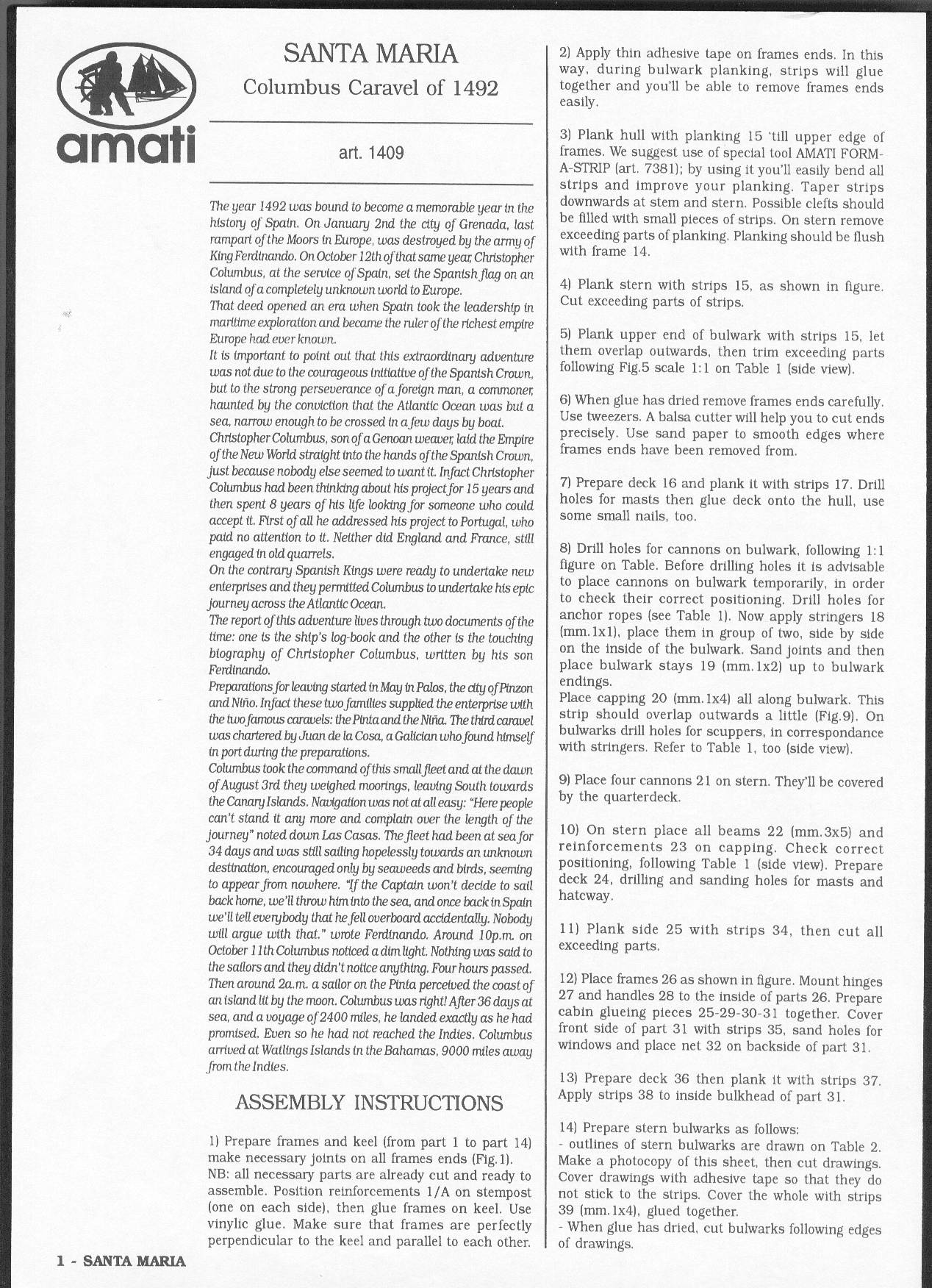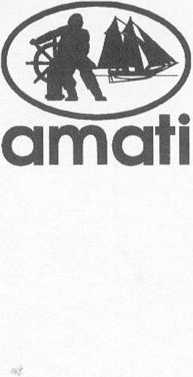Santa Maria 1


SANTA MARLA
Columbus Caravel of 1492 art. 1409
The year 1492 was bound to become a menwrable year in the htstory oj Spain. On January 2nd the city oj Grenada, last rampart oj the Moors (n Europę, roas destroyed by the army of King Ferdtnando. On October 12th oflhat same year, Chrtstopher Columbus, at the sernice oj Spain, set the Spanishjlag on an island oj a completely unknown world to Europę.
That deed opened an era when Spain look the leadership In martttme exploratton and became the ruler oj the rtchest empire Europę had euer known.
It is Important to point out that this extraordinary adoenture U)as not due to the courageous Initiatiue oj the Spanish Crown, but to the strong perseuerance of aforelgn man, a commoner, haunted by the conotction that the Atlantic Ocean was but a sea, narrow enough to be crossed In aJew days by boat. Chrtstopher Columbus, son ofaGenoan weauer, laid the Empire oj the New World stralght Into the hands oj the Spanish Crown, jusl because nobody else seemed to want it. Injact Chrtstopher Columbus had been thinklng about his projectJor 15 years and then spent 8 years of his Uje looklngjor someone who could accept it. First ojall he addressed his project to Portugal, who patd no attention to it. Netlher did England and France, stlll engaged <n old quarrels.
On the contrary Spanish Ktngs were ready to undertake new enterprises and they permttted Columbus to undertake his epic journey across the Atlantic Ocean.
The report oj this aduenture iiues through two documents oj the time: one is the shlp’s log-book and the other is the touching blography of Chrtstopher Columbus, written by his son Ferdinando.
Prepamtlons for leauing started in May in Patos, the dty oJPlnzon and Nino. Injact these two famllles supplied the enterprise wlth ihe two famous carauels: tire Pinia and the Nitra. The thlrdcanauel was chartered by Juan de la Cosa, a Galtclan whoJound htmself lir portduring the preparutions.
Columbus look the command oj this smali Jleet andat the dawn oj August 3rd they wetghed moortngs, leauing South towards the Canary Islands. Naulgation was not at all easy: “Here people can’t stand it any morę and complatn ouer the lerrgth oj the journey” noted down Las Casas. The Jleet had been at sea Jor 34 days and was still saillng hopelessly towards an unknown desttnation, encouraged only by seaweeds and birds, seeming to appear Jrom nowhere. “If the Captain woni declde to sali back home, we il throw hlm into the sea, and once back in Spain weil tell euerybody that heJell ouerboard accidentally. Nobody will argue wtth that." utratę Ferdinando. Around lOp.m. on October 11 th Columbus noticed a dlm llght. Nothing utas said to the sallors and they didni nottce anythtng. Four hours passed. Then around 2a.m. a sallor on the Plnta percelued the coastoj cur Islarrd lit by the moon. Columbus was right! Ąjler 36 days at sea, and a uoyage oj2400 miles, he landed emctly as he had promised. Euen so he had not reached the Indies. Columbus arriued at Watltngs Islands (n the Bahamas, 9000 miles away from the Indies.
ASSEMBLY INSTRUCTIONS
1) Prepare frames and keel (from part 1 to part 14) make necessary joints on all frames ends (Fig. 1). NB: all necessary parts are already cut and ready to assemble. Posltion reinforcements 1/A on stempost (one on each side), then glue frames on keel. Use vinylic glue. Make surę that frames are perfectly perpendicular to the keel and parallel to each other.
2) Apply thln adhesive tape on frames ends. In this way, during bulwark planking, strips will glue together and you'll be able to remove frames ends easily.
3) Plank hull wlth planking 15 'till upper edge of frames. We suggest use of speclal tool AMAT1 FORM A-STRIP (art. 7381); by using it you’11 easily bend all strips and improve your planking. Taper strips downwards at stem and Stern. Possible clefts should be filled wlth smali pieces of strips. On stern remove exceeding parts of planking. Planking should be flush wlth frame 14.
4) Plank stern with strips 15, as shown in figurę. Cut exceeding parts of strips.
5) Plank upper end of bulwark with strips 15, let them overlap outwards, then trim exceedlng parts following Fig. 5 scalę 1:1 on Table 1 (side view).
6) When glue has dried remove frames ends carefully. Use tweezers. A balsa cutter will help you to cut ends precisely. Use sand paper to smooth edges where frames ends have been removed from.
7) Prepare deck 16 and plank it with strips 17. Drill holes for masts then glue deck onto the hull, use some smali natls, too.
8) Drill holes for cannons on bulwark, following 1:1 figurę on Table. Before drilling holes it is advisable to place cannons on bulwark temporarily, in order to check their correct positioning. Drill holes for anchor ropes (see Table 1). Now apply strlngers 18 (mm. 1x1), place them in group of two, side by side on the inside of the bulwark. Sand joints and then place bulwark stays 19 (mm. 1x2) up to bulwark endlngs.
Place capping 20 (mm. 1x4) all along bulwark. This strip should overlap outwards a little (Fig.9). On bulwarks drill holes for scuppers, in correspondance wlth strlngers. Refer to Table 1, too (side view).
9) Place four cannons 21 on stern. They’11 be covered by the ąuarterdeck.
10) On stern place all beams 22 (mm. 3x5) and reinforcements 23 on capping. Check correct positioning, following Table 1 (side view). Prepare deck 24, drilling and sandlng holes for masts and hatcway.
11) Plank side 25 wlth strips 34, then cut all exceeding parts.
12) Place frames 26 as shown in figurę. Mount hinges 27 and handles 28 to the inside of parts 26. Prepare cabin glueing pieces 25-29-30-31 together. Cover front side of part 31 with strips 35, sand holes for Windows and place net 32 on backside of part 31.
13) Prepare deck 36 then plank it wlth strips 37. Apply strips 38 to inside bulkhead of part 31.
14) Prepare stern bulwarks as follows:
- outlines of stern bulwarks are drawn on Table 2. Make a photocopy of this sheet, then cut drawings. Cover drawings with adhesive tape so that they do not stlck to the strips. Cover the whole with strips 39 (mm. 1x4), glued together.
- When glue has dried, cut bulwarks following edges of drawings.
1 - SANTA MARIA
Wyszukiwarka
Podobne podstrony:
santa with a bag of toys ©2005 • ThctolomgSpolcoŁ AD rięWs r«s<rv«i
47870 New Forms Taschen 214 Notes 1 Wigloy, Mark, in: Deconstruc-twist Architectur
New Forms Taschen 091 Fumihiko Maki National Museum of Modern Art Kyoto. Japan, 1983-86 Fumihik
New Forms Taschen 092 Mario Borta San Francisco Museum of Modem Art San Francisco, Califomia. 1990-9
S20C 409120813070 & The Art of Exquisite Felted KnitsGiną Wilde Forcword by Yoshiko Twa m o to W
Art Newspaper, The Art of Record Production journal Art on Paper Art on the linę Art on View : the N
New Forms Taschen 214 Notes 1 Wigloy, Mark, in: Deconstruc-twist Architecture. The
d6 permin of danish art needlework14-7112 i stcłfet - i vaven - in !he labric * in dem S(oł - in de
Waldemar Deluga The History of Studics over the Orthodos Art on the Turn of the 19th and 20th Centur
S20C 409120813070 & The Art of Exquisite Felted KnitsGiną Wilde Forcword by Yoshiko Twa m o to W
218 ARTYKUŁY MARIA MILLER Main Library of Warsaw University of Technology e-mail:
049?ck cover Favorite Themes Turn to this giant bank of clip art to jazz up just about anything—and
FmSf^of cu*y Z Art £.9*7 t>*n<3 £ cs.. J& p IZ ffc&y- —*
więcej podobnych podstron